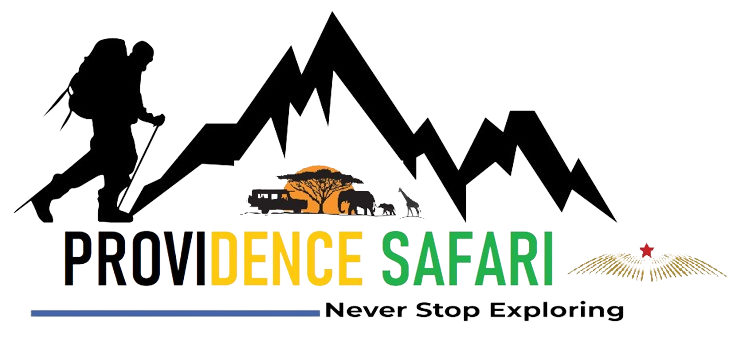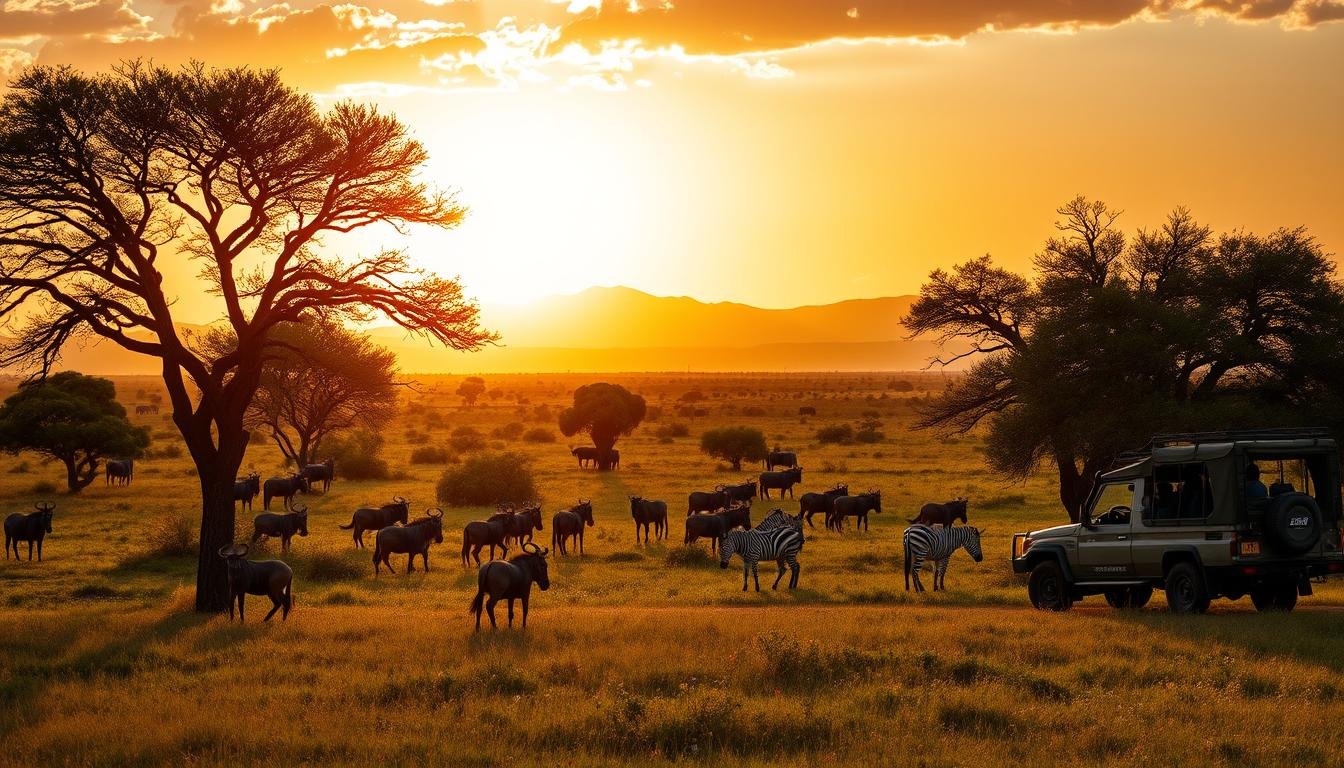Embarking on an African safari in Tanzania is a truly transformative experience, offering a chance to witness nature’s wonders in their most pristine form. However, timing your journey can be crucial in maximising your chances of encountering the country’s diverse wildlife and captivating landscapes. This comprehensive guide provides expert insights to help you identify the optimal period for your Tanzanian safari adventure1.
With a wealth of safari options spanning 5,724 Tanzania Safaris offered by various tour operators1, it’s essential to plan your trip carefully to make the most of your time and budget. Whether you’re seeking the thrill of the wildebeest migration, the tranquility of the Ngorongoro Crater, or the challenge of scaling Mount Kilimanjaro, this guide will equip you with the knowledge to plan your perfect Tanzanian escape1.
Key Takeaways
- Discover the best time to embark on an African safari in Tanzania for optimal wildlife viewing and adventure
- Explore the seasonal patterns, from the dry season to the wet season, and their impact on safari experiences
- Uncover the prime months for witnessing the awe-inspiring wildebeest migration and Mara River crossings
- Identify the ideal times to visit Tanzania’s top safari destinations, such as Serengeti National Park and Ngorongoro Crater
- Plan your Tanzanian getaway with confidence, maximising your chances of encountering the Big Five and other captivating species
Introduction
Tanzania is renowned for its diverse and abundant wildlife, making it a premier destination for African safaris2. However, the optimal time to visit can vary greatly depending on your specific interests and travel goals. This guide will delve into the seasonal nuances, highlighting the best periods for wildlife viewing, the wildebeest migration, and other key activities, to help you determine the ideal time for your Tanzanian safari2.
With over 120 tribes and more than 500 species of birds, Tanzania offers a wealth of cultural and natural wonders to explore3. From the iconic Serengeti National Park, home to one of the highest densities of predators and the only place to witness tree-climbing lions3, to the stunning Ngorongoro Crater, a habitat for rare black rhinos3, this East African nation is a true gem for safari enthusiasts.
The best time for a safari in Tanzania is from June to August, with the spectacular Mara River crossing occurring in June and July2. The peak months for visiting are July and August, characterized by the Great Migration, dry season, and milder temperatures2. However, the months of January and February offer fewer vehicles and greener landscapes after the short rains2, making them an attractive option for those seeking a more intimate safari experience.
Whether your passion lies in wildlife viewing, mountain climbing, or beach holidays, Tanzania has something to offer throughout the year. By understanding the seasonal variations and planning your trip accordingly, you can maximize your chances of having an unforgettable Tanzanian safari adventure.
Seasonal Overview: Wet vs Dry
Tanzania’s climate is defined by two distinct seasons – the tanzania dry season and the tanzania wet season4. The long dry season in Tanzania spans from June to October, characterised by unusual rainfall patterns with fine, clear, and sunny weather4. Another rainy season, called the ‘short rains,’ occurs in November and December in Tanzania, which are lighter and less reliable than the long rains4. January and February mark Tanzania’s ‘short dry season’ following the short rains, before rainfall picks up again in March4.
Dry Season (June to October)
The dry season, from June to October, is generally considered the prime time for safaris in Tanzania, as the lack of rainfall makes wildlife more visible around watering holes and the vegetation is less dense45. Travelling during the post-wet season offers a unique experience with lush greenery, abundant birdlife, and fewer crowds in parks5.
Wet Season (November to May)
The wet season, from November to May, sees the landscape transforming into a lush, verdant wonderland, but can also bring challenges for game viewing due to the increased foliage4. Tanzania’s main rainy season, or the ‘long rains’, typically lasts in March, April, and May with afternoon tropical downpours4. While the wet season may present some logistical challenges, it offers a chance to experience the country’s vibrant wildlife and natural beauty in a different light6.
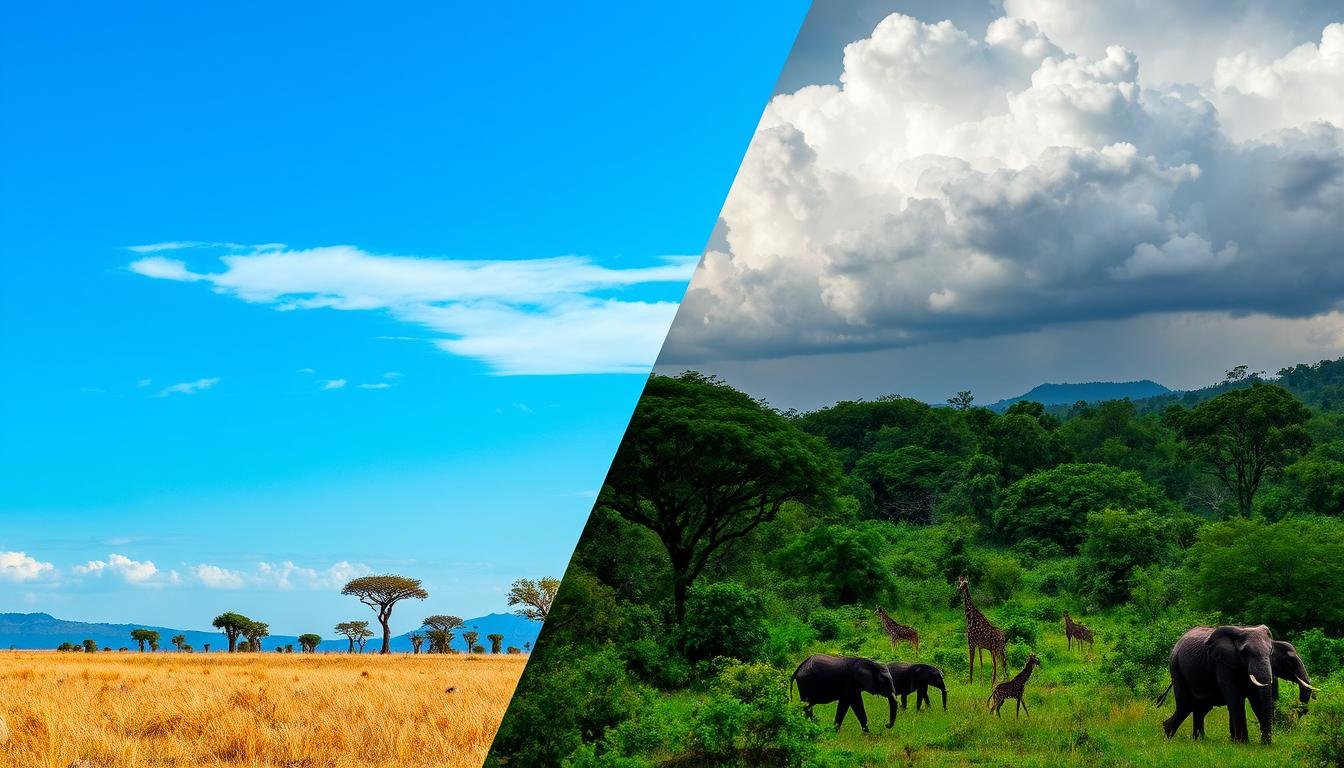
The weather patterns in other African countries like Botswana, Kenya, Malawi, Mozambique, Namibia, Rwanda, Seychelles, South Africa, Zambia, Zanzibar, and Zimbabwe vary compared to Tanzania, each having unique climatic conditions4.
| Season | Months | Weather Characteristics | Wildlife Viewing |
|---|---|---|---|
| Dry Season | June to October | Minimal rainfall, clear skies, and sunny weather | Excellent, as animals congregate around water sources |
| Wet Season | November to May | Increased rainfall, lush vegetation, and tropical downpours | Good, but visibility may be reduced due to dense foliage |
When is the Best Time for Wildlife Viewing?
The best time for wildlife viewing in Tanzania varies depending on your specific interests and the animals you hope to encounter. Tanzania’s dry season, which typically lasts from June to October, is generally considered the prime time for consistent and reliable game viewing7. During this period, the animals congregate around limited water sources, making them easier to spot7.
However, the wet season, from November to May, also has its advantages7. This is the time when you may have the opportunity to see newborn animals and a diverse array of migrating birds7. By understanding the seasonal patterns, you can optimise your safari to maximise your chances of spotting the wildlife you’re most interested in7.
- The dry season from June to October offers excellent wildlife viewing opportunities, with mild temperatures ranging from 12°C to 25°C7.
- The rainy season from November to May brings lush landscapes and the potential to see newborn animals, though game viewing may be slightly more challenging7.
- The best months for a Tanzania safari are typically July, August, and September, when the weather is mild, and animal sightings are plentiful7.
By carefully planning your Tanzania safari around the seasonal patterns, you can maximise your chances of witnessing the incredible wildlife that calls this country home7.
“Tanzania offers a truly unique and unforgettable wildlife experience, with the best time to visit depending on your personal preferences and the species you hope to see.”8
Spotlight on the Wildebeest Migration
One of the most captivating natural wonders in Tanzania is the iconic wildebeest migration, an annual circular journey undertaken by over two million wildebeests, zebras and gazelles across the Serengeti and Maasai Mara ecosystems9. This awe-inspiring spectacle attracts thousands of safari enthusiasts to Tanzania, eager to witness the dramatic crossings of the Mara River and the calving season in the southern Serengeti.
Wildebeest Calving Season
The calving season, which takes place in the southern Serengeti from January to March, offers a unique opportunity to observe the birth of thousands of wildebeest calves91011. This is a time of great activity and vulnerability, as the newborn calves take their first steps and the herds gather in preparation for their northward migration.
Mara River Crossings
The dramatic Mara River crossings, typically occurring between July and September, are a true highlight of the wildebeest migration911. As the herds make the perilous journey from Tanzania’s Serengeti to Kenya’s Maasai Mara, they must navigate the swift-flowing waters of the Mara River, often facing predators such as crocodiles and lions. Witnessing these crossings is a truly awe-inspiring.
| Key Phases of the Wildebeest Migration | Timing |
|---|---|
| Calving Season | January to March |
| Northward Migration | April to May |
| Grumeti River Crossing | June to July |
| Mara River Crossing | August to September |
| Southward Migration | October to November |
| Calving Season | December |
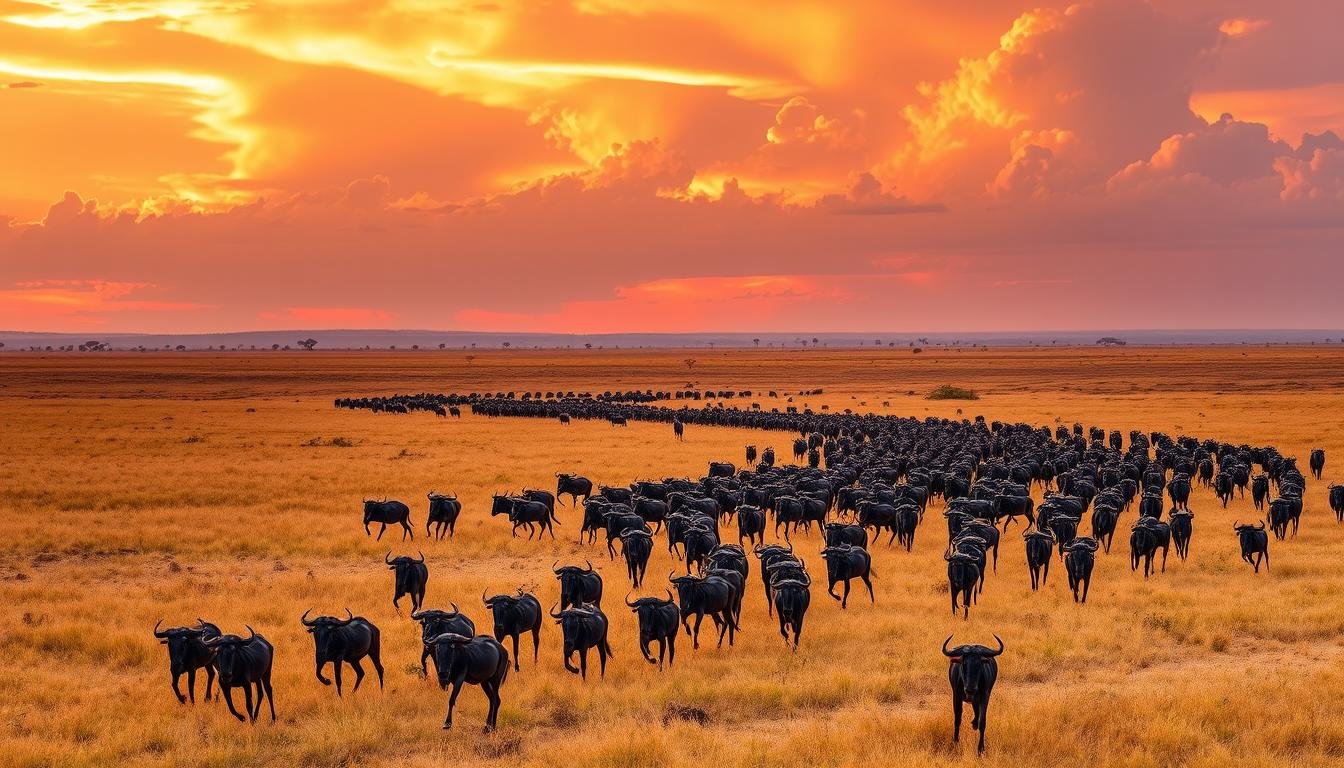
“Witnessing the wildebeest migration is a truly humbling and awe-inspiring experience. To see millions of these animals undertake this remarkable journey is a sight that will stay with you forever.”
Whether you choose to witness the calving season or the dramatic river crossings, the wildebeest migration is a must-see natural wonder that showcases the resilience and sheer scale of Africa’s wildlife. Plan your safari in Tanzania to coincide with this incredible event and create memories that will last a lifetime91011.
Tanzania’s Top Safari Destinations by Season
Tanzania is home to a diverse array of national parks and protected areas, each offering unique seasonal highlights for safari enthusiasts. From the legendary Serengeti National Park to the awe-inspiring Ngorongoro Crater and the diverse Tarangire National Park, the best time to visit these destinations can vary greatly depending on your interests and the wildlife spectacles you wish to witness12.
Serengeti National Park
The Serengeti National Park is renowned for the remarkable wildebeest migration, which involves around 1.5 million wildebeests, zebras, and gazelles12. The best time to visit the Serengeti largely depends on whether you want to witness the calving season or the dramatic river crossings. From January to March, the southern Serengeti plays host to the calving season, with approximately 400,000 wildebeest calves born during this period12. The northern Serengeti experiences the Great Migration crossing the Mara River into Kenya’s Maasai Mara Game Reserve in July12.
Ngorongoro Crater
The Ngorongoro Crater offers excellent year-round wildlife viewing, with a high concentration of wildlife, including rhinos, elephants, and lions, within its vast caldera13. Visitors can enjoy diverse safari experiences, such as game drives and walking safaris, to immerse themselves in the natural splendor of this unique natural wonder.
Tarangire National Park
Tarangire National Park is particularly renowned for its large elephant populations during the dry season between June and October12. The park is also home to over 500 bird species, making it a true paradise for birdwatchers14. Tarangire offers a variety of safari activities, including game drives, walking safaris, and even catch-and-release fishing, providing visitors with a diverse range of experiences.
Each of these top safari destinations in Tanzania offers a unique perspective on the country’s rich wildlife and diverse ecosystems. By understanding the seasonal variations and planning your trip accordingly, you can ensure an unforgettable safari experience in this enchanting African nation12.
| Destination | Best Time to Visit | Key Highlights |
|---|---|---|
| Serengeti National Park | January to March (calving season), July (Mara River crossings) | Wildebeest migration, calving season, Mara River crossings |
| Ngorongoro Crater | Year-round | High concentration of wildlife, including rhinos, elephants, and lions |
| Tarangire National Park | June to October (dry season) | Large elephant populations, diverse bird species (over 500) |
Best Time for African Safari Tanzania
Determining the best time for an African safari in Tanzania ultimately depends on your personal preferences and the specific experiences you hope to have. While the dry season is generally considered the prime time for wildlife viewing, the wet season also offers unique opportunities, such as witnessing newborn animals and migratory bird species15. By understanding the seasonal nuances and aligning your travel plans with your interests, you can ensure a truly unforgettable Tanzanian safari adventure.
The well-travelled northern safari circuit of Tanzania, including the Serengeti, Ngorongoro Crater, and Lake Manyara, boasts the highest concentrations of big game in Africa15. The dry months from June to October are considered the best time to explore these destinations, as animals congregate around water sources15. Additionally, the Serengeti’s river-crossing season usually occurs during this period15.
However, the wet season from November to May also offers unique opportunities. During this time, you may witness the birth of newborn animals and observe the arrival of migratory bird species15. While the weather may be more unpredictable, the lush, green landscapes provide a captivating backdrop for your safari experience.
For those seeking a more off-the-beaten-path adventure, Ruaha National Park is a hidden gem. This park is larger than the Serengeti but receives only a fraction of the visitors15. The Great Ruaha River is a lifeline for wildlife, with large lion prides and leopards commonly seen along its banks15.
Whether you prefer the dry or wet season, Tanzania offers a wealth of opportunities to immerse yourself in the wonders of African wildlife. By understanding the seasonal nuances and aligning your travel plans with your interests, you can create an unforgettable safari experience that exceeds your expectations.
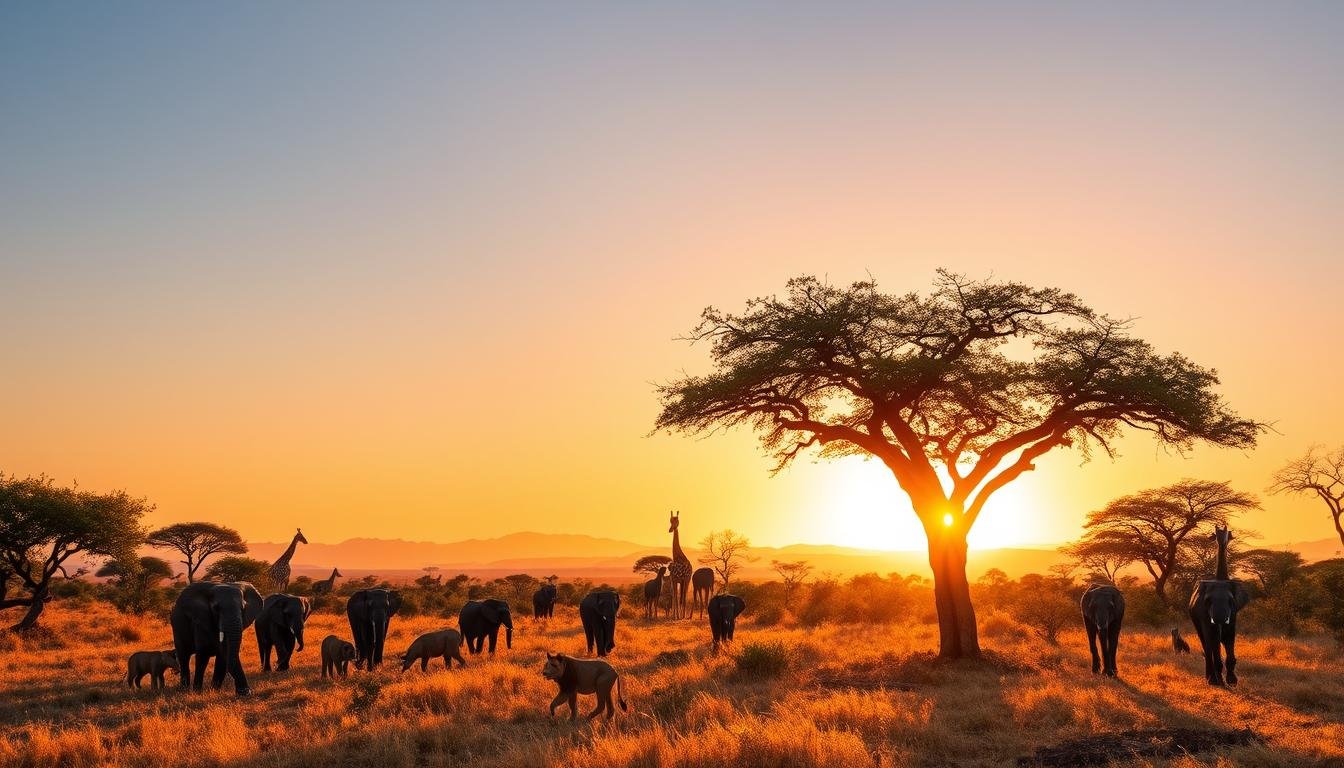
| Destination | Best Time for Safari |
|---|---|
| Serengeti National Park | July to October |
| Ngorongoro Crater | June to October |
| Tarangire National Park | June to October |
| Ruaha National Park | June to October |
By planning your Tanzania safari during the dry season from June to October, you can maximize your chances of witnessing the highest concentrations of wildlife15. However, the wet season from November to May also presents unique opportunities, such as observing newborn animals and migratory bird species15. Regardless of the season, Tanzania’s diverse national parks and private reserves offer an unforgettable safari experience for adventurous travellers.
Combining Safari with Beach Holidays
Many travellers choose to combine their Tanzanian safari with a beach holiday, taking advantage of the country’s stunning coastline and islands16. Tanzania offers a variety of safari and beach holiday packages ranging from 9 to 13 days in duration16. Popular safari and beach holiday itineraries include trips to Serengeti & Zanzibar, Northern Tanzania Safari & Zanzibar Beach, and Zanzibar Sands & Saadani Safari Trails16.
Zanzibar’s Peak Season
Zanzibar, in particular, is a popular addition to a Tanzanian itinerary, with its idyllic beaches and vibrant culture16. Some of the best beaches in Tanzania are found in Zanzibar, known for its beautiful beaches such as Nungwi Beach, Kendwa Beach, and Matemwe Beach16. The peak season for visiting Zanzibar typically coincides with the dry season, from June to October, when the weather is sunny and dry, making it an ideal time to relax on the beach after an exhilarating safari17.
17 Zanzibar is highlighted as a top beach destination in combination with safari itineraries, and the itinerary for a luxury safari and beach holiday includes 3 nights at Masai Mara and 5 nights in Zanzibar16. Pemba Island and Mafia Island are also popular beach destinations in Tanzania, offering features like lush forests, excellent diving, snorkelling, and marine protected areas16.
16 Zanzibar, Pemba Island, and Mafia Island are safe for swimming, with pleasant water temperatures and calm waves, although visitors should be cautious of tides, undercurrents, and sea life16. Tanzania’s beaches provide excellent opportunities for activities such as swimming, sunbathing, snorkelling, diving, and other water activities16. The combination of safari and beach holidays in Tanzania offers a diverse vacation experience with the excitement of wildlife safaris and the relaxation of beachside retreats16.
Ideal Months for Climbing Kilimanjaro
For adventurous travellers, Tanzania’s iconic Mount Kilimanjaro offers a challenging and rewarding hiking experience. The best time to climb Kilimanjaro is typically during the dry season, from mid-June to mid-October, and from December to mid-March1819. These periods have the most stable weather conditions, making the ascent more comfortable and safer for climbers.
According to Ian Taylor Trekking, a leading adventure travel company, the top months for climbing Kilimanjaro are January, February, June, July, August, September, and October20. The company further narrows down the selection to February, July, and August as the top 3 best months for the ascent20.
The warm months of January and February provide clear skies for excellent views of Mount Kilimanjaro’s superb scenery19. June to August is the driest period on the mountain, making it highly favourable for trekking19. September is also a popular time, as it coincides with the prime wildebeest migration season19.
While Kilimanjaro can be climbed year-round, the weather on the mountain is unpredictable, with swings between very hot and extremely cold conditions18. It is advisable to avoid the rainy seasons of mid-March to May and November to December1819.
| Month | Climbing Conditions |
|---|---|
| January – February | Warm, dry, clear skies |
| June – August | Dry, favourable for trekking |
| September | Warm, dry, coincides with wildebeest migration |
| Mid-March – May | Rainy, hazardous conditions |
| November – December | Sporadic showers, less cold than June-August |
Both climbing Kilimanjaro and visiting the Serengeti can be done year-round, but better views and easier climbs are more likely during the dry seasons18. The beginning of the year is best for a combined Kilimanjaro and safari tour in the southern Serengeti during the short dry season and wildebeest calving18.
It’s important to note that the summit success rate for climbing Kilimanjaro is typically 50-60% annually, and the amount of time spent on the mountain significantly impacts the chances of summiting20. Physical preparedness and allowing enough days for the climb are essential factors to consider20.
“Kilimanjaro has been successfully climbed by children and octogenarians, but it is a perilous undertaking with altitude sickness being a significant risk factor.”19
Birdwatching in Tanzania
Tanzania is a true paradise for birdwatching enthusiasts, boasting over 1,000 species of birds within its borders21. The best time to embark on a birding adventure in Tanzania is during the wet season, from December to March, when migratory birds arrive from Europe and Asia, joining the resident avian species21. This ‘green season’ offers the perfect opportunity to spot a diverse array of colourful and captivating birds, from the vibrant bee-eaters to the stately secretary birds.
Tanzania is home to a vast array of endemic and near-endemic bird species, such as the Usambara Weaver and the Udzungwa Partridge, making it a true haven for avid birders22. Popular birding hotspots in the country include the Serengeti National Park, Lake Victoria, Saadani National Park, the Usambara and Udzungwa Mountains, and Nyerere National Park, each offering a unique and diverse birdwatching experience21.
While Tanzania’s birding opportunities are excellent year-round, the green season from November to April is considered the best time to visit, as it coincides with the arrival of migratory birds and the breeding activities of the resident species22. A knowledgeable local guide can significantly enhance the birding experience, helping with species identification and spotting rare and elusive birds21.
| Birding Destination | Number of Bird Species |
|---|---|
| Ruaha National Park | 350 |
| Serengeti National Park | over 500 |
| Tarangire National Park | over 550 |
| Ngorongoro Conservation Area | over 500 |
| Lake Manyara National Park | over 400 |
| Rubondo Island National Park | Various endemic and migratory species |
Tanzania’s diverse landscapes, from the sweeping savannas to the lush forests, provide a captivating backdrop for avid birdwatchers22. Whether you’re a seasoned birder or a novice enthusiast, Tanzania offers an unparalleled opportunity to immerse yourself in the world of feathered wonders23.
Tanzania boasts an impressive 1156 confirmed bird species as of September 2021, making it one of the premier birding destinations in Africa23. With 22 endemic and 43 near-endemic bird species, the country is a true haven for avid birders seeking unique and rare avian encounters.
High vs Low Season Considerations
Pricing and Crowds
Tanzania’s safari industry experiences distinct high and low seasons, which can significantly impact various aspects of your trip, including pricing and crowds24.
The high season, typically spanning from July to October, sees the highest influx of visitors to the region, leading to more crowded national parks and higher accommodation and activity costs24. Conversely, the low season, from April to May, offers greater availability, lower prices, and fewer crowds, making it an appealing option for budget-conscious travellers25.
While the high season boasts the advantage of drier conditions, which can make it easier to spot wildlife, particularly in the Masai Mara and Serengeti National Park24, the low season has its own merits. During the main rainy season from March to May, many camps may close down, resulting in lower visitor numbers and, consequently, lower safari prices25.
Ultimately, understanding the trade-offs between the high and low seasons can help you make an informed decision about the best time to plan your Tanzanian safari26. By carefully considering your preferences, budget, and the potential impact of seasonal factors, you can ensure a truly memorable and cost-effective safari experience24.
“The key to a successful safari is finding the right balance between your budget, the weather, and the wildlife viewing opportunities. By understanding the seasonal variations, you can plan a trip that aligns with your preferences and expectations.”
Conclusion
Tanzania’s rich tapestry of wildlife-filled national parks, captivating cultural experiences, and breathtaking natural landscapes make it a premier destination for safari enthusiasts27. With 19 national parks and 7 game reserves, the country offers a diverse range of habitats to explore and abundant opportunities to witness the magnificent African wildlife27. Whether you choose to visit during the dry season from June to October or the wet season from November to May, each period presents its own unique advantages and considerations for the perfect safari adventure.
By understanding the seasonal patterns, wildlife migrations, and top destinations, you can plan your Tanzanian safari to align with your specific interests and travel goals27. The dry season from June to October is renowned for its excellent wildlife visibility and the opportunity to witness the awe-inspiring Great Migration28, while the wet season from November to May offers lush landscapes, fewer crowds, and opportunities for exceptional birdwatching28. With a wealth of information at your fingertips, you can now confidently embark on the African safari of a lifetime, savouring the unforgettable experiences that Tanzania has to offer.
From the iconic Serengeti National Park and the magnificent Ngorongoro Crater to the majestic Mount Kilimanjaro and the serene Olduvai Gorge29, Tanzania’s diverse array of safari destinations and activities cater to a wide range of travellers29. With this comprehensive guide, you can make an informed decision on the best time to visit Tanzania for your dream safari, ensuring an adventure that is tailored to your preferences and fulfilling your wanderlust for the breathtaking wonders of East Africa.
FAQ
What is the best time of year for an African safari in Tanzania?
When is the best time to see the wildebeest migration in Tanzania?
What are the best months for climbing Mount Kilimanjaro in Tanzania?
When is the best time for birdwatching in Tanzania?
What are the differences between the high and low seasons for safaris in Tanzania?
Source Links
- https://www.safaribookings.com/tanzania/best-time
- https://www.responsibletravel.com/holidays/tanzania/travel-guide/best-time-to-go
- https://ellamckendrick.com/7-10-day-tanzania-safari-itinerary/
- https://www.expertafrica.com/tanzania/weather-and-climate
- https://www.audleytravel.com/inspiration/safari-holidays/best-time-to-visit
- https://altezzatravel.com/articles/when-is-the-best-time-for-a-safari-in-tanzania
- https://www.bornwild.rocks/blog2/best-time-to-safari-in-tanzania
- https://www.brilliant-africa.com/tanzania/when-to-visit
- https://www.detourafrica.com/wildebeest-migration/
- https://www.ubuntutravelgroup.com/blog/great-migration-guide/
- https://blog.rhinoafrica.com/2023/07/23/when-and-where-to-see-the-great-wildebeest-migration/
- https://kenyaluxurysafari.co.uk/tanzania-safaris/african-safari-tanzania/
- https://www.simbavati.com/tanzania-safari/
- https://www.go2africa.com/destinations/tanzania/where-to-go
- https://www.cntraveller.com/article/tanzania-safaris
- https://www.tentwithaview.com/experiences/safari-and-beach-holidays.html
- https://safariandbeach.com/
- https://fairvoyage.com/best-season-to-climb-kilimanjaro-and-go-on-safari/
- https://www.africanmeccasafaris.com/travel-guide/tanzania/parks-reserves/mount-kilimanjaro/trek-climb/best-time
- https://iantaylortrekking.com/blog/best-months-for-climbing-kilimanjaro/
- https://www.tentwithaview.com/experiences/bird-watching-in-tanzania.html
- https://www.focuseastafricatours.com/blog/the-best-times-and-places-for-bird-watching-in-tanzania/
- https://africanbirdingtrips.com/tanzania-birding-safari-trips/
- https://www.bornwild.rocks/blog2/visiting-tanzania
- https://smilewithustoursafrica.com/tanzania-safari/best-time-to-visit-tanzania/
- https://www.africatravel.com/traveltips/the-best-time-for-safari-in-kenya-and-tanzania
- https://medium.com/@shammahwonderssafaris10/best-time-to-visit-tanzania-and-kenya-9f9a7358e2e8
- https://bonobosafricansafariholidays.com/when-is-the-best-time-to-visit-tanzania/
- https://www.kandooadventures.com/blog/10-reasons-why-tanzania-is-the-best-safari-destination-1129.html
